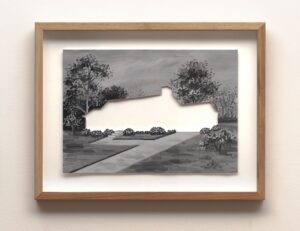Amber Koroluk-Stephenson, The Bayou, 2014, oil on paper, 29.72 x 41.91cm.
Houses all lined up next to one another. Occupying an area of precious square meterage. These houses are beacons of suburbia, real estate hotspots, architecture of times gone by. But are houses not just bricks and mortar?
What is it that makes a house a home?
As I get older I begin to realise more and more the importance of having a place that I can call home. This is a place of comfort, warmth, security and a place of belonging.
Having grown up in a family that moved around a lot, traveling to amazing parts of the world and living in some, I often feel the urge to “go some place else”. My brother, Max has it the worst of all of us only being able to stay in one place for two years at a time before he needs to jet set again. And with all this moving around you begin to ask yourself, “What is home?”
As I look upon Amber Koroluk-Stephenson’s black and white kit home painting series like shadows hovering off the wall and off the page I am led up the path into the memory of my childhood home. To 4 Usher Court. I shut my eyes and I can remember every little detail of that house the steps up to the front porch and through the front door. I can navigate my way through that house, knowing exactly how wide the hall is (wide enough for my five-year-old body to be able to climb up walls hinging one leg at either side of the hallway), the feel of the carpet under my feet, the smell of jasmine, the touch of the cool wall in the dry heat of the day. The location of the light switch as I enter my room, the number of steps to climb to the top bunk to resume the teddy bears picnic all laid out. The sound of Max playing with the ants along the driveway and mum pottering around in the garden, the smell of dad’s tobacco wafting in from the veranda. And running through the water sprinkler, jumping on the trampoline and rollerblading as fast as I can around the house.
I am taken back to that house and every element of it feels so ingrained into my every being. I remember the gumtrees in the front yard that Max and I used to climb and jump from one tree to the next without a care in the world. The smell of the sap when we had to have those trees cut down. Dad said it was to increase the market value of our property. My six-year-old mind didn’t know what that meant but I guessed it was pretty important.
We travelled to Tucson, Arizona soon after those trees were cut down. We travelled all around America, we went to Disney Land (!), we travelled throughout Europe, and my parents even enrolled us into a school in England, “to experience a different education system, they told us. Both being teachers everything became a ‘learning experience’ during this yearlong teachers exchange. A good family friend who visited us many times throughout that year remarked, “Every time I visit Polly has a different accent; Australian, American, English, back to American and now Australian again.” I think if we’d stayed in Italy any longer I probably would have picked up the language.
I remember being hit with the incredible heat when we stepped off the plane. For my parents, 4 Usher Court was never the same after that year away but to me it was the best place we’d visited yet. I was so happy to be home – to the smell of jasmine and dead ants and grass burning in the hot sun. For me, this place will always be home. Amber Koroluk-Stephenson’s paintings remind me of that, of that house and all the memories that were created there.
And I realise that home is memories. The house is just the shell that holds them.
What makes a house a home? is the commissioned catalogue essay I wrote for Amber Koroluk-Stephenson’s solo exhibition titled Half Full / Half Empty at Sawtooth ARI, Launceston in March 2014.
